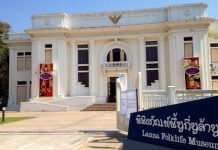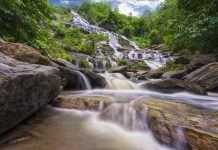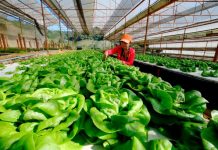
Wat Phra Singh Waramahavihan or known in short name is “Wat Phra Singh” is a Buddhist royal temple of the first grade locates near the city wall and moat of Chiang Mai in Phra Singh sub-district, Muaeng Chiang Mai. Wat Phra Singh is one of the significant temples in Chiang Mai. It is an example of the supreme art of Lanna where a place to house Phra Sing or an official name is Phra Buddha Si Hing, a critical a potent religio-political symbol of Chiang Mai and the Lanna Empie. Phra Buddha Si Hing is known as “Chiang Saen Singh Nueng”. The Buddha image is in the attitude of subduing Mara and sitting cross-legs with legs locked together. Moreover, according to the folk belief of Lanna, one who was born in the year of dragon or Naga should come to make the worship at this temple once in the life of luck.
History of Wat Phra Singh Waramahavihan
According to the historical record noted that Phya Pha Yu, the fifth king of Mangrai dynasty ordered to construct in 1345 AD. Firstly, a 46-meter chedi to house the ashes of his father Phya Kham Fu, then in the next two years the other buildings including a monastery, monk’s dwelling, sermon hall in a monastery, and Hor Trai (the temple library) were built. So, the complex was completed finally and named is “Wat Li Chiang Phra”, and invited Phra Thera Aphai Chula and the monks to stay in the monastery. The community in front of the temple is a marketplace of the city; therefore, the temple was known in general is “Wat Li Chiang” (Li means market); nonetheless, the villagers preferred to call “Kad Li”.
During the reign of the King Saen Muaeng Ma (Phya Saen Muaeng 1388 – 1411) ascended to the throne of Chiang Mai. There was a battle between Chiang Mai and Chiang Rai, and Chiang Mai gained the victory. On the way to back, the king Saen Muaeng Ma respectfully invited Phra Buddha Si Hing to Chiang Mai by the river Ping. When the ship that carried the sacred image arrives at the pier of the city at Wang Singh Kham Pier, there was an aura from the image shone about 4,000 meters to the northeast while the statue was transferring to the movable throne. And later, the temple called “Wat Fa Ham” which means the resplendent temple was established on that location.
Initially, The king Saen Muaeng planned to house Phra Buddha Si Hing at Wat Bupparam (Wat Suan Dok) where locates outside the town to the west. However, once the image reached Wat Li Chiang Phra then could not move forward. The king then took this as an auspicious sign and decided to build a mondop (square hall with a pyramidal roof to house the sacred Phra Buddha Si Hing at this temple instead. The holy Buddha image was shined in 1367 resulting the temple was named “Wat Phra Singh” according to the name of the image. The temple had renovated by times in particular during the 1920s that the whole complex experienced extensive renovations under the famous monk Khru Ba Srivichai. Many of the edifices were again restored in 2002.
The Fine Arts Department declare in which the national archaeological site on March 8, 1935, together with many monasteries in Chiang Mai. Then, the temple was bestowed to be the royal temple in the first grade on November 23, 1940, and renamed as “Wat Phra Singh Waramahawihara” from that time on. And it was published the demarcation in the Government Gazette on June 16, 1979.
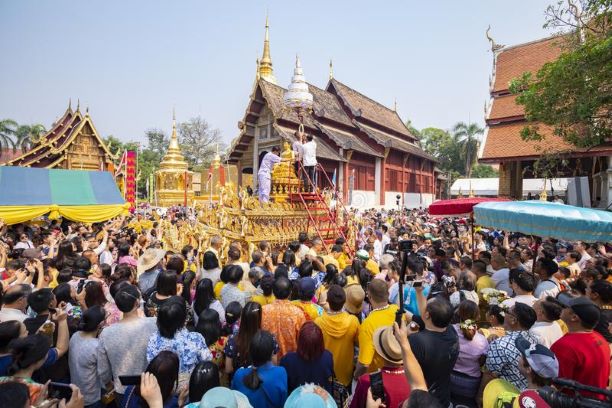
Every year, during the Songkran festival, the image is taken from Vihara Lai Kham and carried through the streets of Chiang Mai in a religious procession during which the spectators esteem the statue by sprinkling water over it.
The Story of Phra Buddha Si Hing Statue
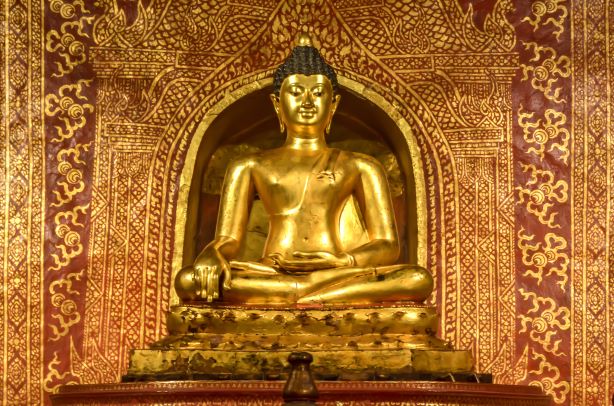
Phra Buddha Si Hing or Phra Singh is an ancient Buddha image made from bronze coated with gold in the attitude of sitting cross-legs with legs locked together with 79 cm high and 63 cm of lap width. The image is Lanka style. According to the record noted that king Si Ha La, a king of Lanka created the image in 157 AD. Then the ruler of Nakhon Si Thammarat asked for the statue to present to Phra Ruang king of Sukhothai. And when Sukhothai was a dependency of Ayutthaya empire, Somdet Phra Borommarachathirat I the king of Ayutthaya invited Phra Buddha Si Hing to Ayutthaya. Later, the statue relocated to Kampaengpat and Chiang Rai. And when king Saen Muaeng Ma of Lanna conquered Chiang Rai, the figure was invited to house at Chiang Mai together with the Emerald Buddha. And during the period of Narai the Great of Ayutthaya, the king gained the victory over Lanna in 1662 and brought the sacred image to shine at Wat Phra Si Sanphet. The Phra Buddha Si Hing had been here for 105 years. And the second of the failure of Ayutthaya the people of Chiang Mai respectfully invited the sacred statue back to the city. And after Siam got the independence back from Burma, King Rama 1 of Chakkri dynasty invited the image to Bangkok in 1767. Presently, the supreme sacred statue houses at Buddhaisawan Chapel, Bangkok’s National Museum. During the Songkran festival annually, the statue is taken from the chapel for the people to worship and sprinkle water onto a Buddha image. And one house at the Wat Phra Singh is Phra Singh replica.
What to See at Phra Singh temple
1. Ubosot
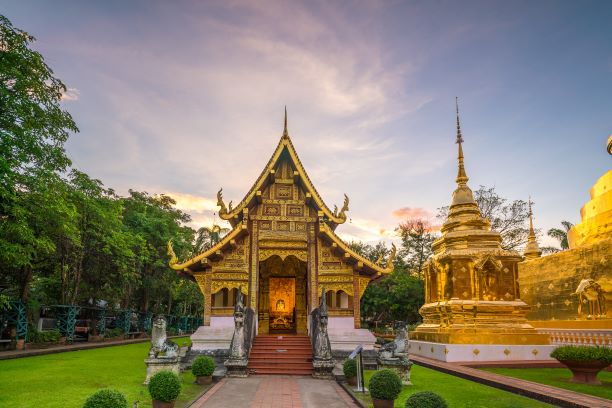
It is a rectangular edifice contains two entrances both front and back. The architecture and interior are traditional Lanna. From the side can see the massive window with trelliswork; however, it is a real piece of window. The archway entrance decorated with fresco, and the pediment is a join of two curves and eye-like circles above the door. Moreover, there are frescoes decorate at the pillars and other parts of the building that look very exotic.
2. Ho Trai (the temple library)
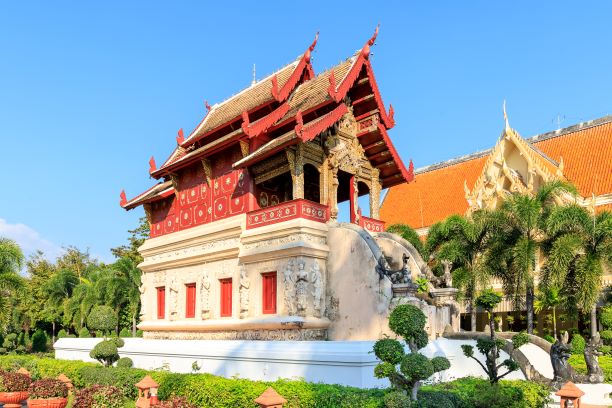
With the reputation as one of the most beautiful temple libraries in Thailand, Ho Trai at Wat Phra Singh is another sample of the delicate Lanna work of art. A half concrete half wooden building with fresco decoration on the exterior wall in Deva Phanom figures (the figure of deva clasping hand in) is the work of artisan during the period of Phra Muaeng Keaw (1495 – 1525 AD.). And in 1933, the building was renovated by the Prince Kaew Nawarat, the ruler of Chiang Mai. The interior was decorated with many figures of the Himmapan creatures – the mermaid with the wings, Kochasri (a mixed lion that borrows head features from an elephant), Ghilen, etc. Besides, there is Pra Cham Yarm pattern similar to Meng of Chinese.
3. Vihara Lai Kham
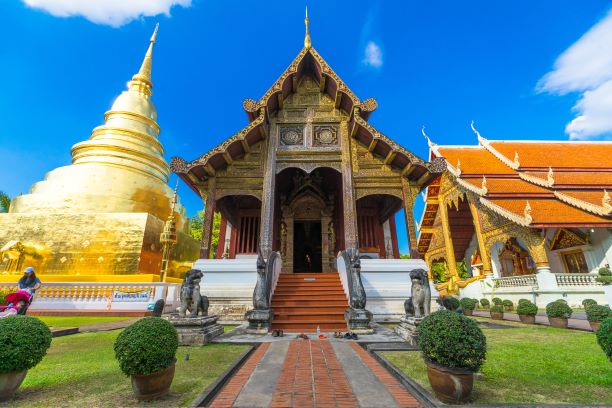
Vihara Lai Kham has the delicate and exotic fresco works which represent the most propitious era of art. The hall is classical Lanna architecture with a couple of Naga flanking along both sides of the staircases and a couple of lion statues. The Vihara Lai Kham is a house to enshrine Phra Buddha Si Hing replica. On the wall behind the main Buddha image is the marvellous golden line painting on the red background. The wall in the north of the hall decorated by the authentic portrayal of the story of Sangthong, and the story of Suwannahongsa in the south. In particular of Sangthong painting which can be found here only. Professor Silpa Bhirasri (Corrado Feroci) Italian sculptor who is the Father of Thai Contemporary Art summarised about the outstanding character of Lanna mural which is “the northern mural is usually painted about the daily life that is realistic. And to sight, the beauty of Sangthong painting inside the Vihara Lai Kham, Wat Phra Singh, Chiang Mai is like we flashback to the real situation that occurred in the last century.”
Other Attractive Things in Wat Phra Singh
1. Phra Chao Thong Thip
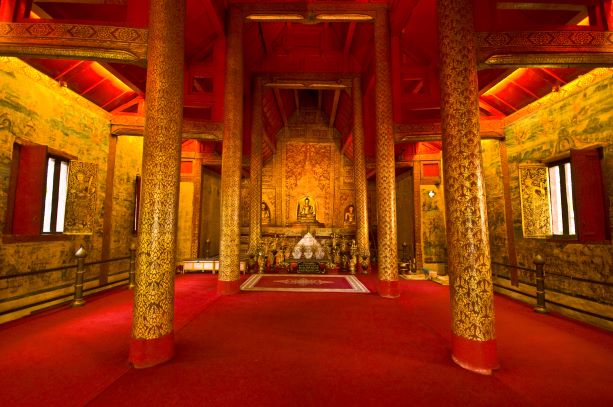
It is an ancient Buddha image that was created by King Tilokkarat, the 12th king of Mangrai dynasty to remembrance on the occasion of the eighth Buddhist Council at Chiang Mai in 1477. Presently, the temple creates the image replica to enshrine on the mondop inside ubosot of Wat Phra Singh.
2. Phra Sisanpeth (Luang Pho To)
It is the primary Buddha image locates inside Vihara Luang of Wat Phra Singh Waramahavihan. It is a stucco Buddha that assumed the main image of the original vihara that was dismantled during the renovation by Khru Ba Srivichai and replaced to Vihara Luang.
3. Phra Chao Than Chai
It is a god who is giving you one wish instantly. A stucco God statue with unknown time of the origin, nonetheless telling by the old people is hundreds year of age and housed in Vihara Phra Chao Than Chai.
4. The Reclining Buddha

It is an old stucco Buddha created in 1551 and underwent many restorations which are;
- The first time in 1955, Phra Upali Kunu Pamachan as the principal.
- The second time in 1994, Phra Dham Sitthachan as the principal.
- The third time in 2011, Phra Rajchasingha Voramuni as the principal.
5. Phra Mahathat Chedi (Phra That Luang)
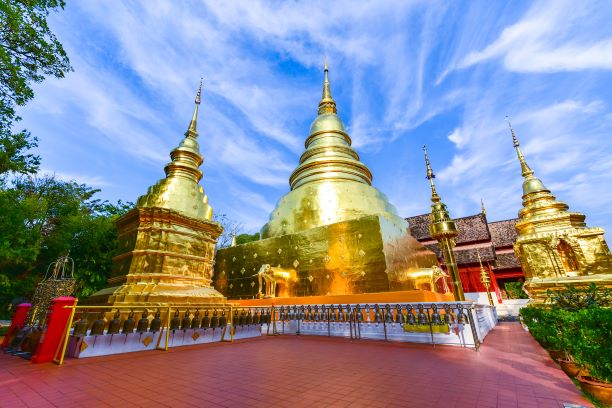
The chedi is 50 meters in its height with the square base. According to the folk legend of Chiang Mai noted that this is a place to house the hair of Buddha and is a stupa of one who was born in the year of Dragon or Naga. Phya Pha Yu created the stupa in 1345. Then between 1558 – 1774 when Chiang Mai was under the power of Burma, the temple including building in the complex were abandoned. Until in 1926, Princess Dara Rasmi, Prince Kaew Nawarat, and Kru Ba Srivichai led the people to renovate the monastery and enlarged the stupa.
6. Kru Ba Srivichai Monument
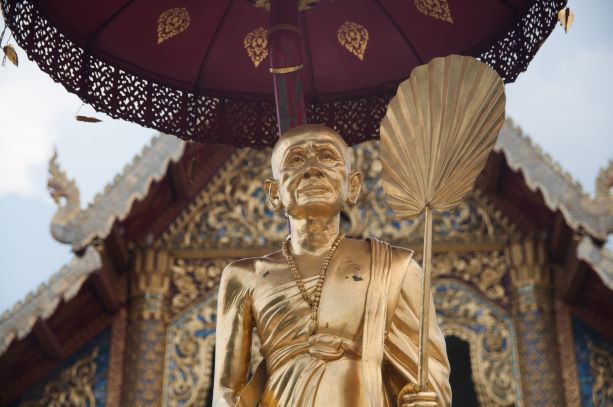
The statue locates at the circle in front of Vihara Luang. It was created as the remembrance of the famous Buddhist monk Kru Ba Srivichai who is former principal of the temple for 13 rainy seasons.
7. The Kulai Chedi
This small square based chedi, built as a pagoda with five tiered roofs by King Mueangkaeo (1495–1525), is connected to Vihara Lai Kham by a short tunnel which is forbidden to visitors. When the pagoda was repaired under King Dharmalanka (1813–1822), a golden box containing ancient relics was discovered. The box and its contents were located once more inside the pagoda after the works were completed.
8. King Mangrai Monument
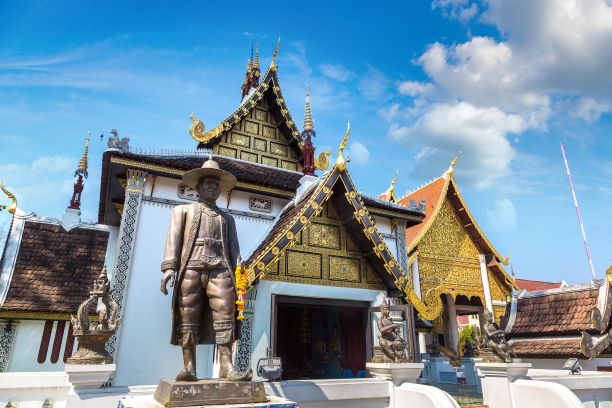
The monument of the first king of Mangrai dynasty who establishes Chiang Mai.
Travel to Wat Phra Singh Woramahavihan
There are two options to get to the temple which are;
By Car:
The temple locates within the wall of moat between Singharaj and Ratchadumneon Road.
By Red Pick-up Truck:
It is the local minibus service that travels around the city. The cost depends on the distance.

